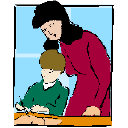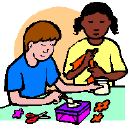 Applied
Behavior Analysis (ABA)
Applied
Behavior Analysis (ABA) 
ABA is a program originally began by Ivar Llovas and is based on Thorndike's operant conditioning. Children recieve individualized programs that cater to their needs in specific areas such as fine motor skills, sequencing, communicative speech, eye contact, and sitting behavior. It systematically breaks down large skills into separate components. Each component is then methodically taught until it is mastered. ABA uses a system of rewards and reinforcers to promote the learning of a new skill as well as the probability of its use within a realistic environment.
|
Antecedent
|
|
Behavior
|
|
Consequence
|
|
"look at me"
|
child looks
|
praise and reward
|
The theory is explained that if an anticedent is given, the correct behavior follows, and a child is given a positive consequence, he or she will desire that consequence, and continue to produce the desired behavior. If an incorrect behavior is given, it should be ignored entirely, such taht it does not receive attention or a reward, and will work to obtain that reward in the future.
Discrete Trial Teaching:
ABA is an extremely repetitive and tedious process. Each session consists of multiple cognitive areas where each area has a specific skill to be addressed. Each skill is repeated for a set number of trials. Each trial consists of an antecedent, a behavior, and a consequence. Only when a child had reached mastery (typically three sessions in a row of 80% or better) can he advance to the next skill. Skills are broken up into tiny steps. For example, a child might be asked to "point to plate" where the plate is the only object set in front of him. When he has mastered this, he would be asked to "point to plate" where there is a plate and something else, another object that is used as a distracter. Next, there would be two distracters. Each skill in each cognitive area would be divided into such steps.
It is key that there be a short period of time, usually about 5 seconds, between each trial. This period allows children to differentiate between trials, gives the instructor a chance to record the results of the trial, and gives the instructor a chance to gain the child's attention for the next trial.
Prompting
Very often, ABA asks children to provide a behavior in which they do not understand what behavior is expected of them. Children can grow very easily frustrated when they do not understand what is expected of them. As a result, prompting is used to show them what they should do. In order to prompt a response, the antecedent must first be given. At this point, a prompt may or may not be given to help the child elicit a response. A prompted response is not recorded as a correct response, but it is reinforced as such. There are four main ways to prompt a response.
Verbal - This type of prompt is when you tell a child what he should do or say in addition to the antecedent.
|
Antecedent
|
|
Behavior
|
|
Consequence
|
|
"What is your name?"
|
"say Ryan"
|
"Ryan"
|
Physical - This type of prompt is when you physically help a child complete a trial.
|
Antecedent
|
|
Behavior
|
|
Consequence
|
|
"Clap hands"
|
pick up child's hands and clap
|
child claps hands
|
Gestural - This type of prompt is when you indicate what the child should be doing.
|
Antecedent
|
|
Behavior
|
|
Consequence
|
|
"Touch red"
|
point to red card
|
child touches red card
|
Positional - This type of prompt is when you position an object to make it easier for the child to complete the trial.
|
Antecedent
|
|
Behavior
|
|
Consequence
|
|
"Touch red"
|
put red card closer to child
|
child touches red card
|
Reinforcement
Reinforcement is the most important aspect of Discrete Trial Teaching. Typically, ABA programs today use only positive reinforcement. Early ABA programs included punishment for incorrect responses, but Lovaas quickly discovered that punishment was having a negative effect on his students. There are two types of reinforcement, primary and secondary.
|
Primary Reinforcers
|
Secondary Reinforcers
|
||
|
Unlearned Rewards
|
Learned Rewards
|
||
|
|
|
|
|
When children are first using ABA, primary reinforcers are the most beneficial to helping them be successful. However, these rewards are not realistic in everyday society and should be paired with secondary reinforcers such as praise. Eventually, secondary reinforcers can be used in solitude in order to make therapeutic sessions as realistic as possible.
Incorrect responses in ABA should be ignored completely. Some of these responses are being given for attention and they should not be acknowledged. Instead, the instructor should make it very clear that that session is over, mark the answer incorrect, and begin a new trial. The simple act of not responding to an incorrect answer lets children know that the given response was not the desired response. They will be motivated to provide another response in order to receive the reward that they are waiting for.
Additional Resources:
One-on-One: Working with Low-Functioning Children with Autism
and Other Developmental Disabilities
Type of Resource: Book
Marilyn Chassman
Publisher: IEP Resources, 1999
ISBN: 1-57861-080-X
Synopsis: Children with low-functioning autism often have difficulty grasping
the concepts of applied behavioral analysis (ABA) and the Pictorial Exchange
Communication System (PECS). This book, written by a mother who has taught her
own autistic son since he was eight, provides suggestions about beginning and
continuing ABA and PECS programs with children who have low-functioning autism
and aggressive tendencies. It begins with very simple ideas about starting out
and develops ways to expand the program focusing on communication skills, matching
skills, receptive skills, academic skills, fine motor skills, large motor skills,
simple computer skills, sensory toleration, self help skills (toilet training),
and minimizing aggression. It also provides sample and reproducible blank forms
that can be used for record keeping to track progress. Chassman's experience
with autistic children is based on her experiences with her son. As a result,
this book is based mainly on the results that were obtained from the experiences
of one child and end when his experiences end. This book will provide parents
and educators information about how to implement ABA and PECS programs for children
with low functioning autism or who have aggressive tendencies.
A Work In Progress: Behavior Management Strategies and a Curriculum
for Intensive Behavioral Treatment of Autism
Type of Resource: Book
Edited by Ron Leaf and John McEachin
Publisher: DRL Books, 1999
ISBN: 0-9665266-0-0
Synopsis: For a parent, teacher, or caregiver with little experience in applied
behavioral analysis (ABA), this book is outstanding. The book begins by discussing
ABA from a historical context, general therapy settings, and general therapy
format. It also explains the importance of reinforcement within therapy and
how to choose proper reinforcement. It discusses general autistic behaviors
and programs that correct some of these behaviors, including self-stimulatory
behaviors and their functions. Toilet training, sleep patterns, eating patterns,
play and social skills are also discussed in great length. The second part of
the book discusses curriculum for discrete trial teaching (the type of instruction
used in ABA), how it is taught, and provides practical strategies. This book
is, however, only a general introduction, and, while it is easier to understand
than other books, does not get into quite as much detail about specific ABA
programs and therapy as some others. This book is ideal for an inexperienced
educator, parent, or caregiver who is looking for general information about
the history and implementation of ABA programs.
Right from the Start: Behavioral Intervention for Young Children
with Autism
Type of Resource: Book
Sandra L. Harris, Ph.D. & Mary Jane Weiss, Ph.D.
Publisher: Woodbine House, 1998
ISBN: 1-890627-02-X
Synopsis: This book is excellent for the novice who would like ABA explained
in simple, layman's terms. It explains the importance behind early intervention
in Autism, some exemplary models, home and center based programs and general
ideas about curriculum. In addition, it discusses some specific cases throughout
the book, allowing parents (and educators) to relate to the stories that are
told. It does not get into specific program details, but it does break down
ABA into it's simplest terms.
Behavioral Intervention for Young Children with Autism: A Manual
for Parents and Professionals
Type of Resource: Book
Edited by Catherine Maurice
Publisher: Pro-Ed, Inc, 1996
ISBN: 0-89079-683-1
Synopsis: Any teacher, parent, or caregiver planning on implementing, carrying
out, or overseeing an ABA program would be highly advised to read this book.
It includes a very broad range of material including research, how to select
teaching programs, how to implement these programs once selected, how to assess
the effectiveness of these programs, how to become qualified in ABA, information
for parents, rights of parents, incorporating speech-language therapy into program,
strategies for promoting language acquisition in children with autism, and information
about inclusion. In addition, it includes specific programs for a number of
issues and suggested tracks that can be followed for each program. It also has
reproducibles that can be used for the purpose of recording student responses.
This book is told from the point of view of a group of researchers who advocate
ABA and believe that many of the "alternative" therapies are not effective.